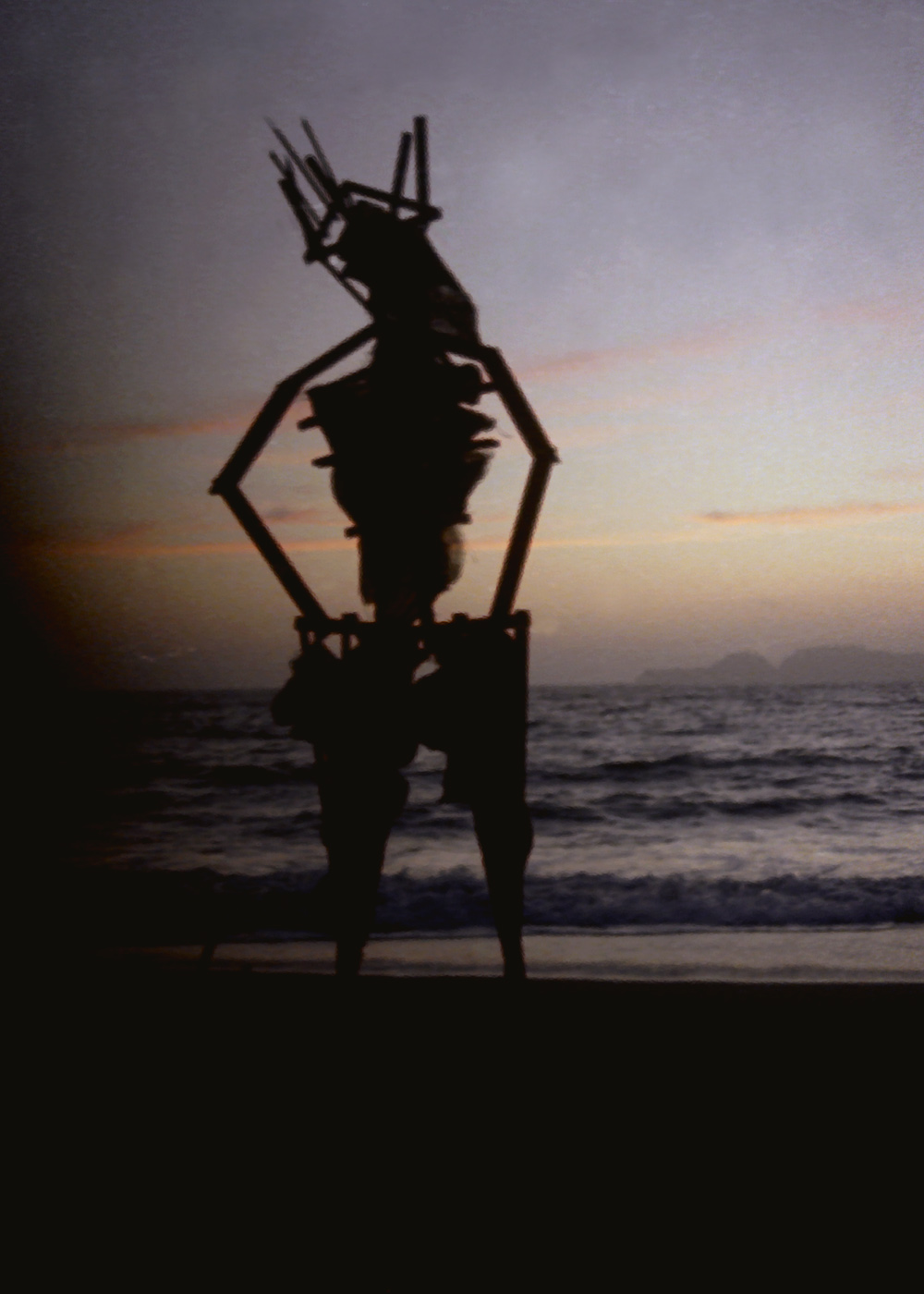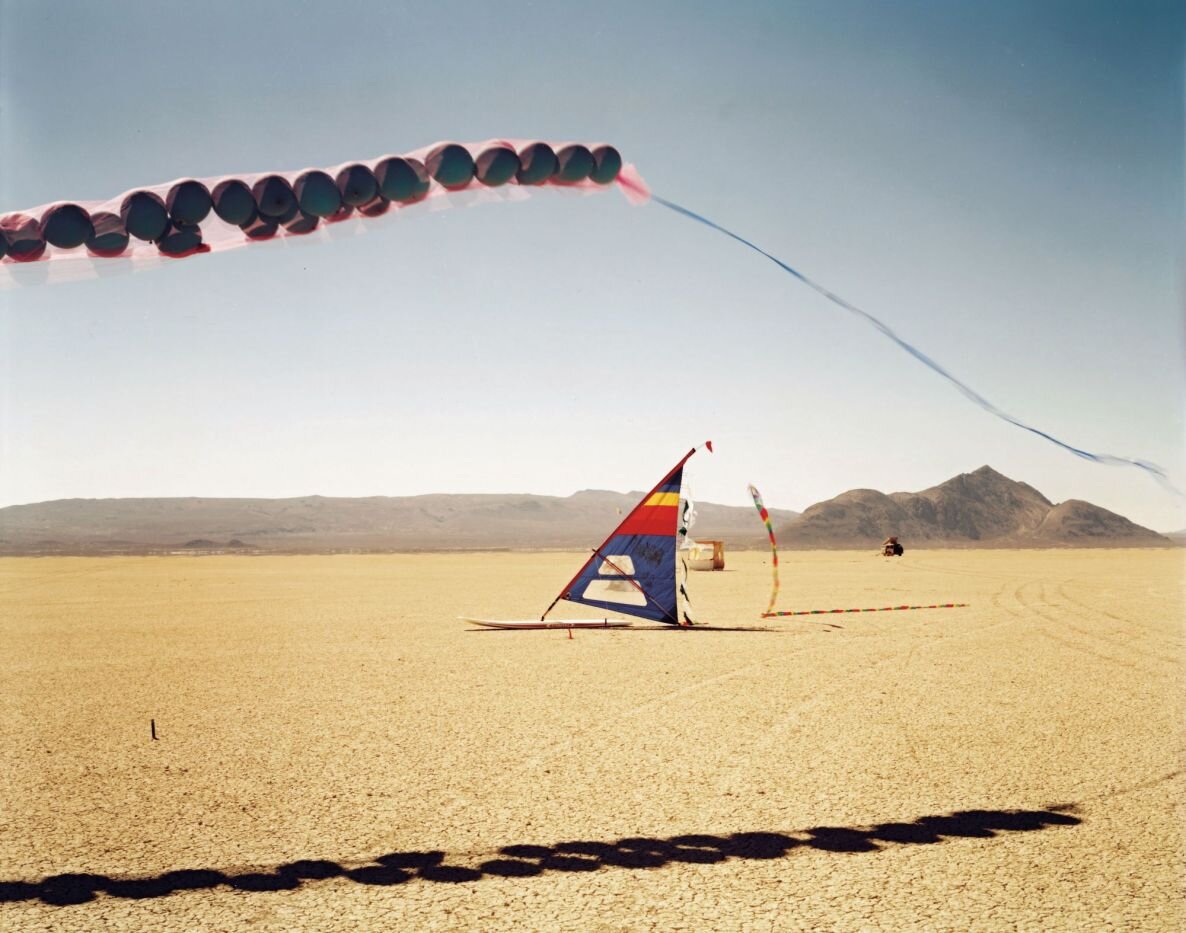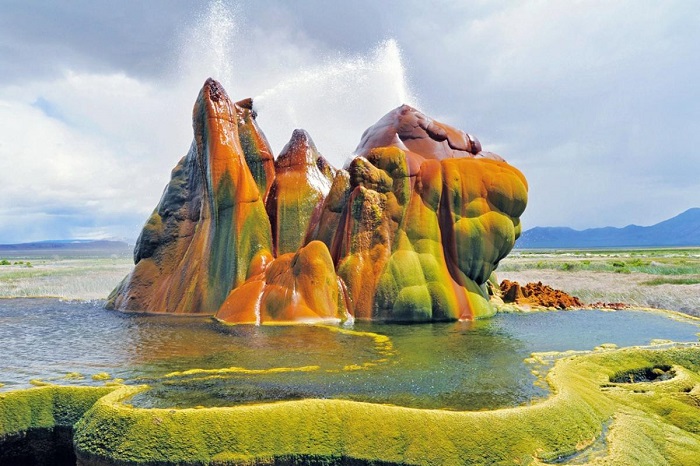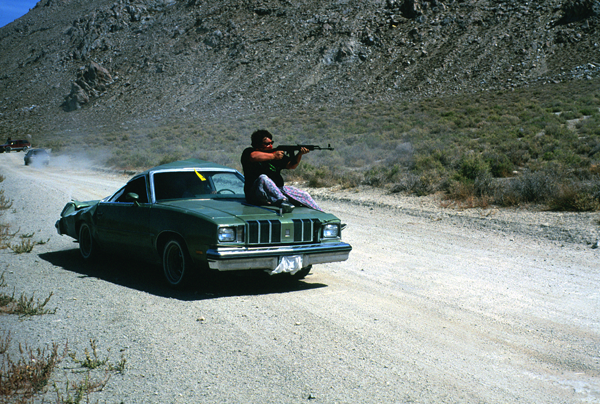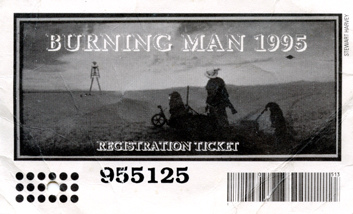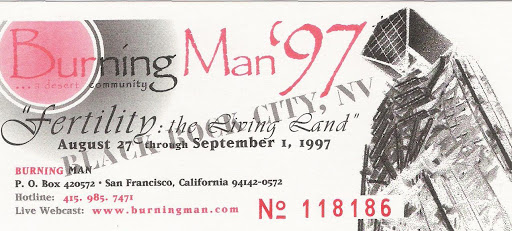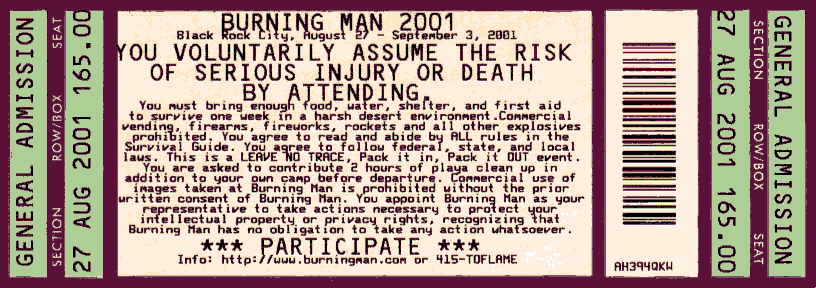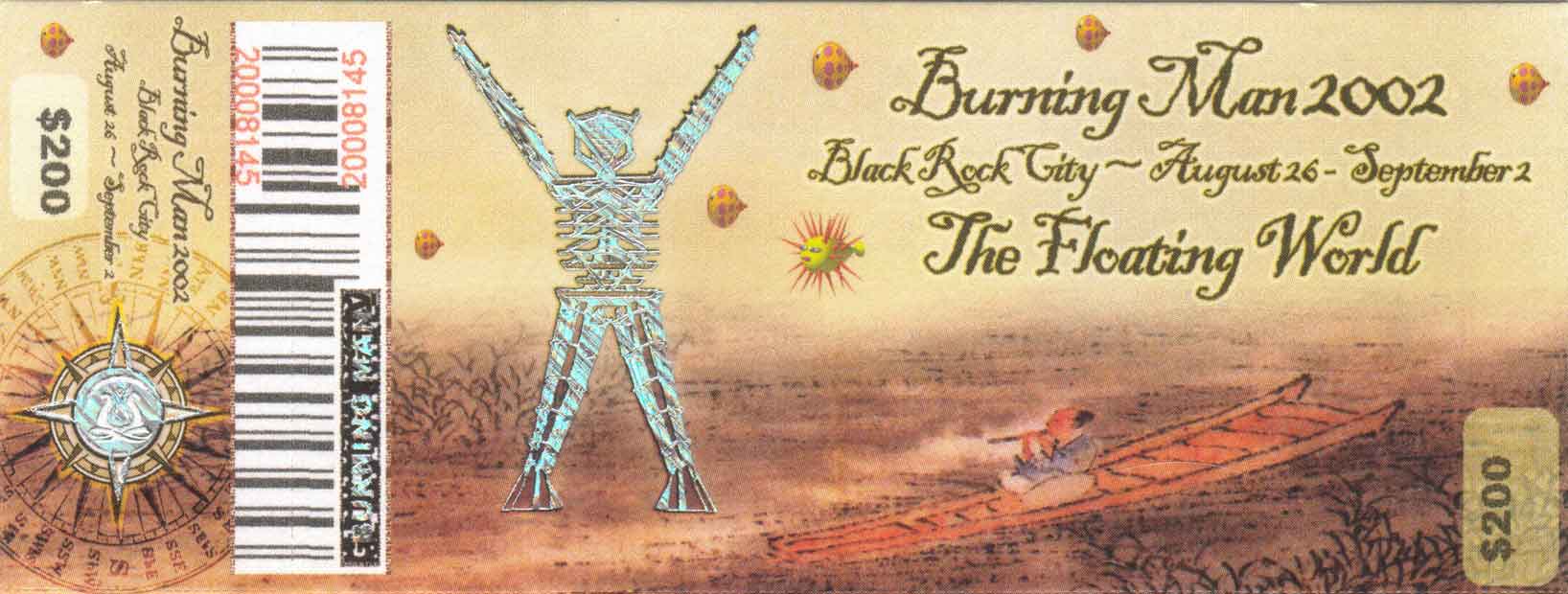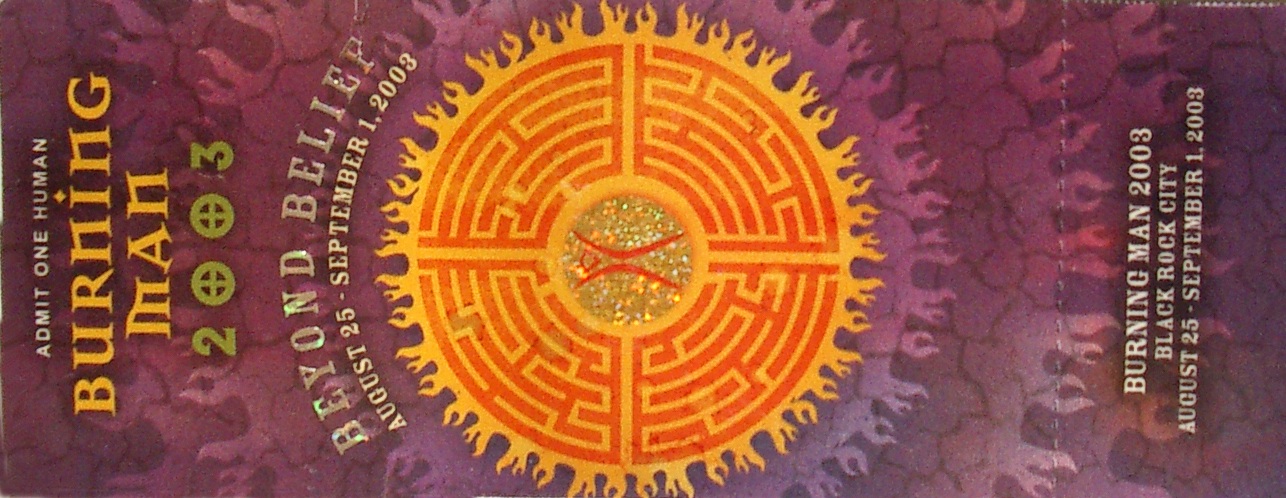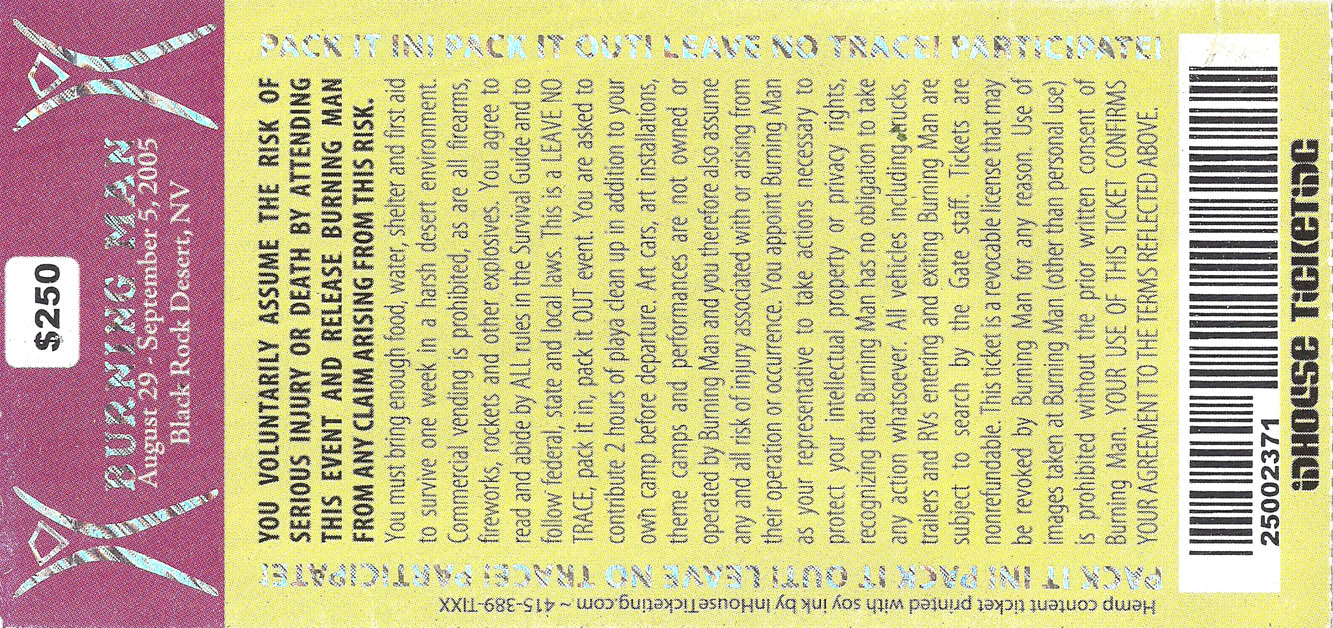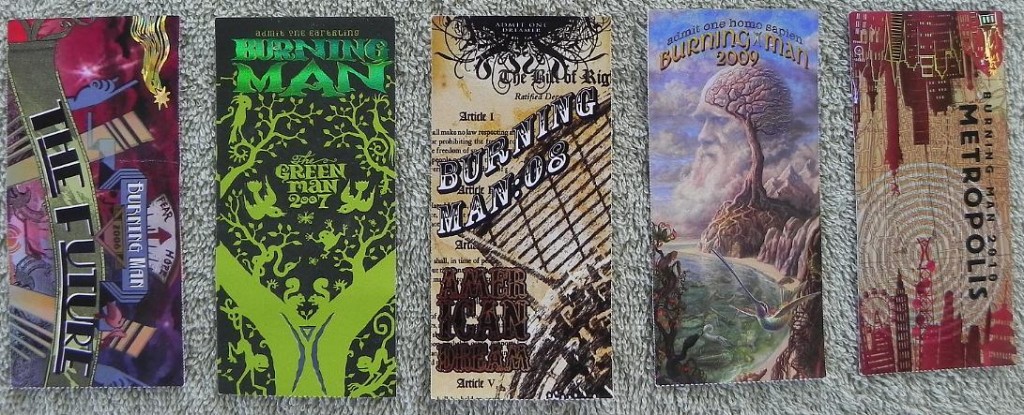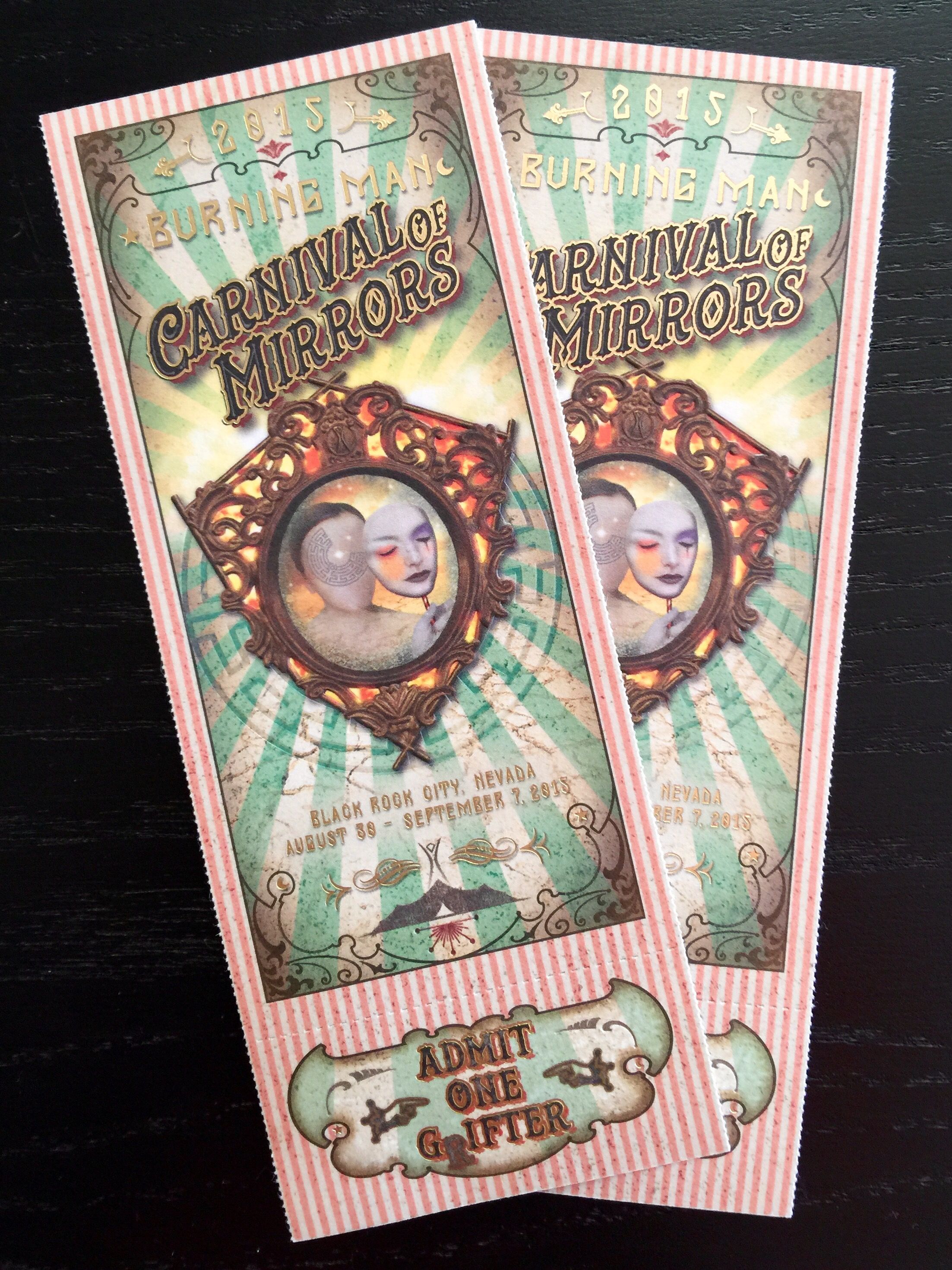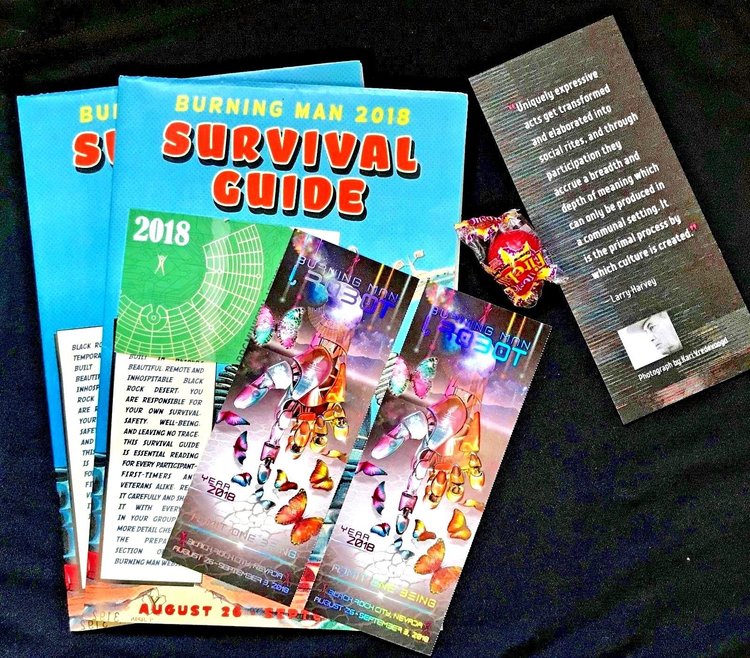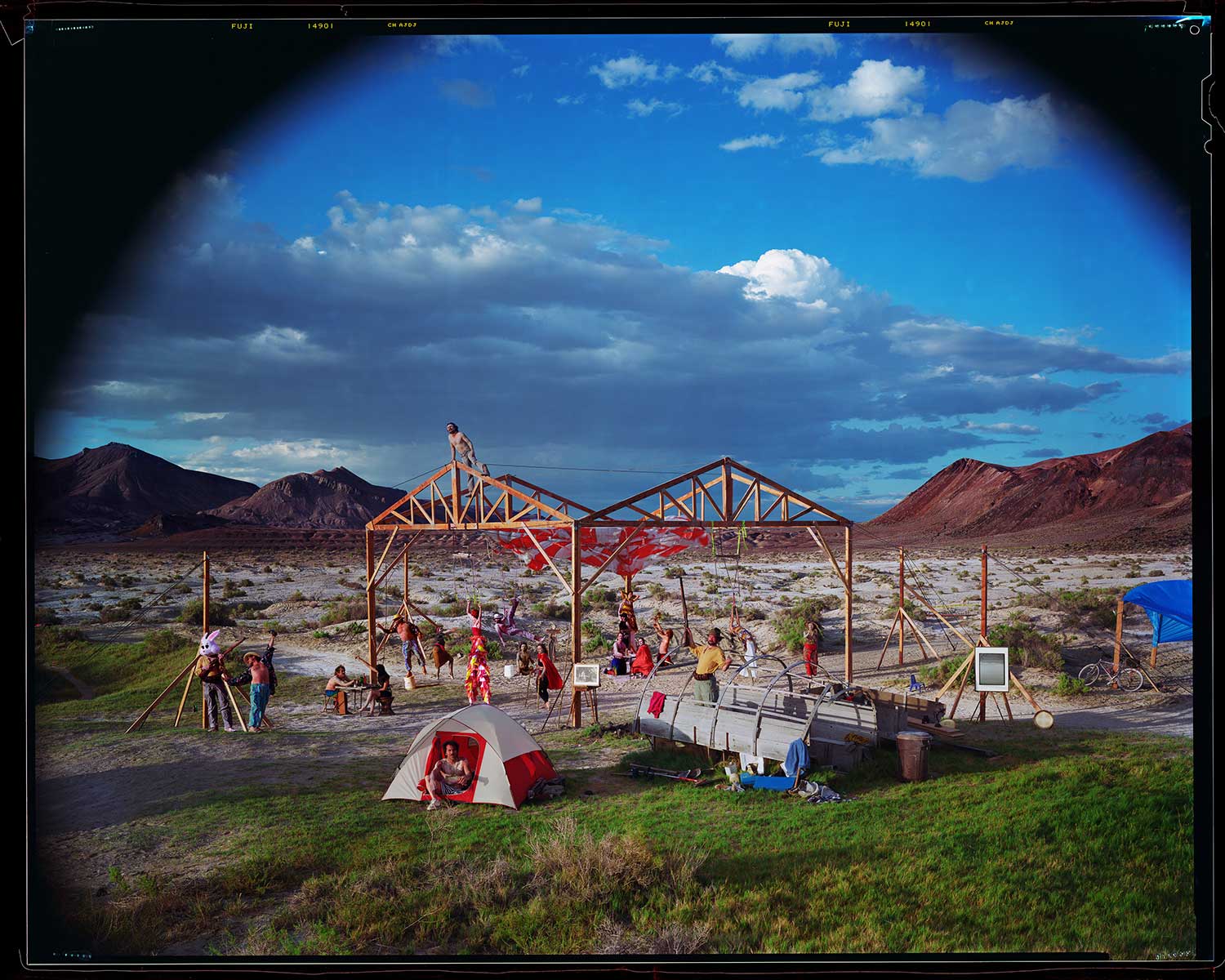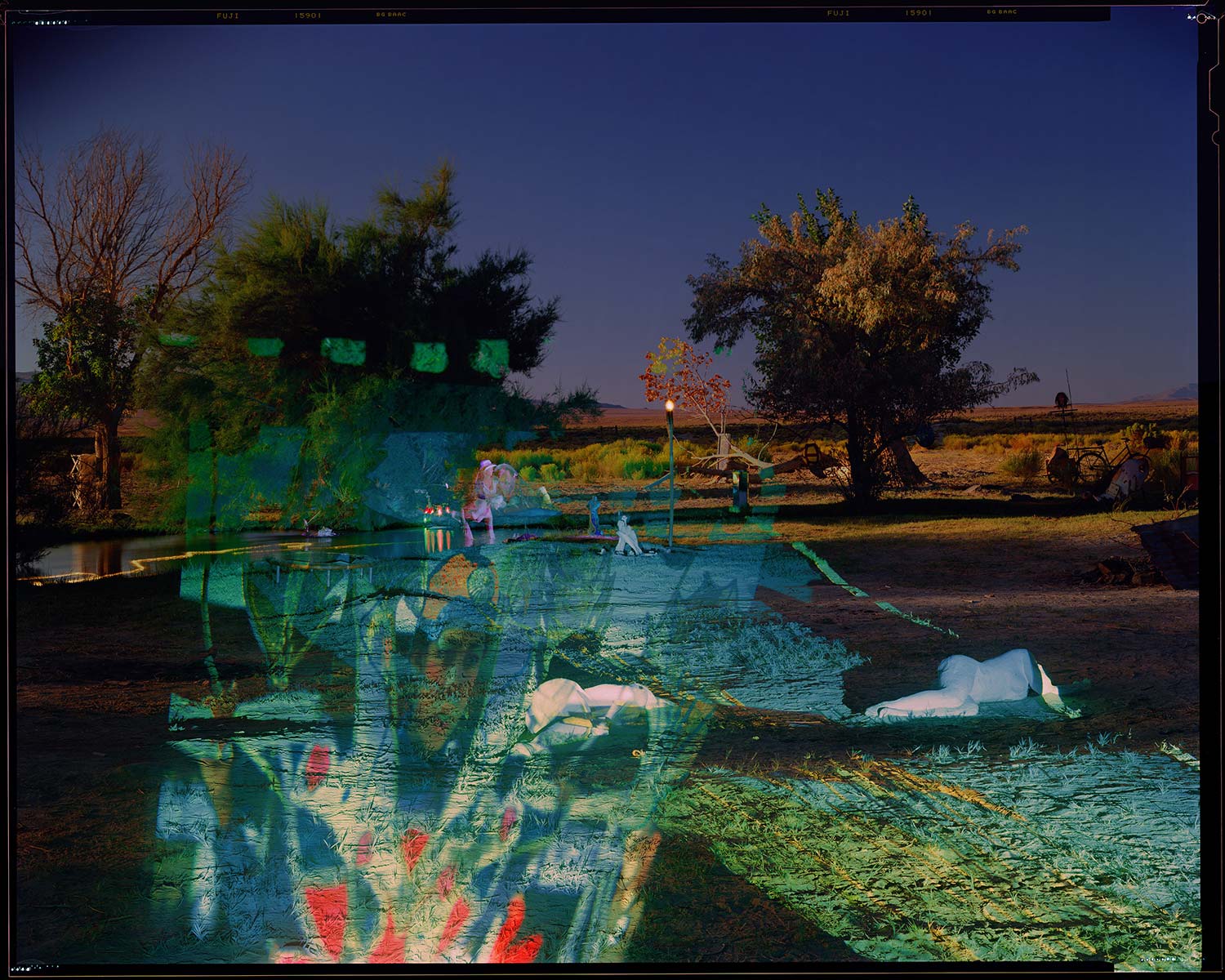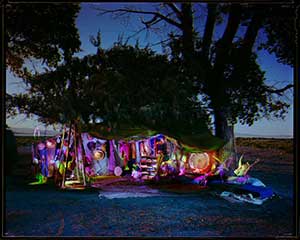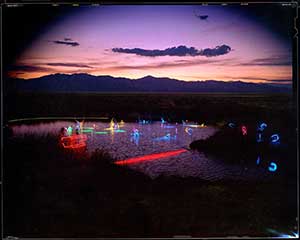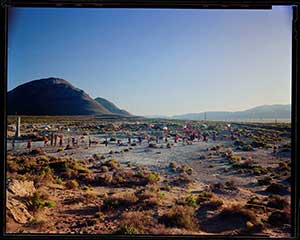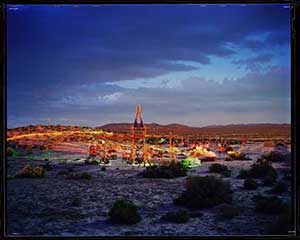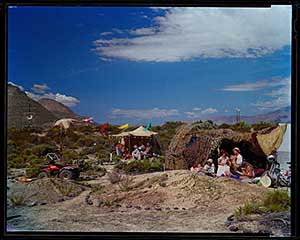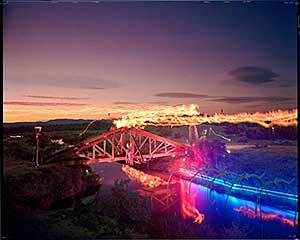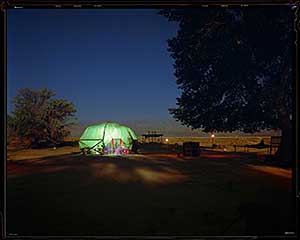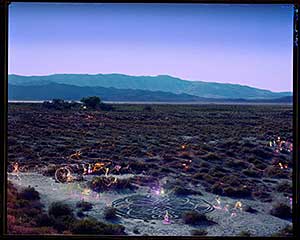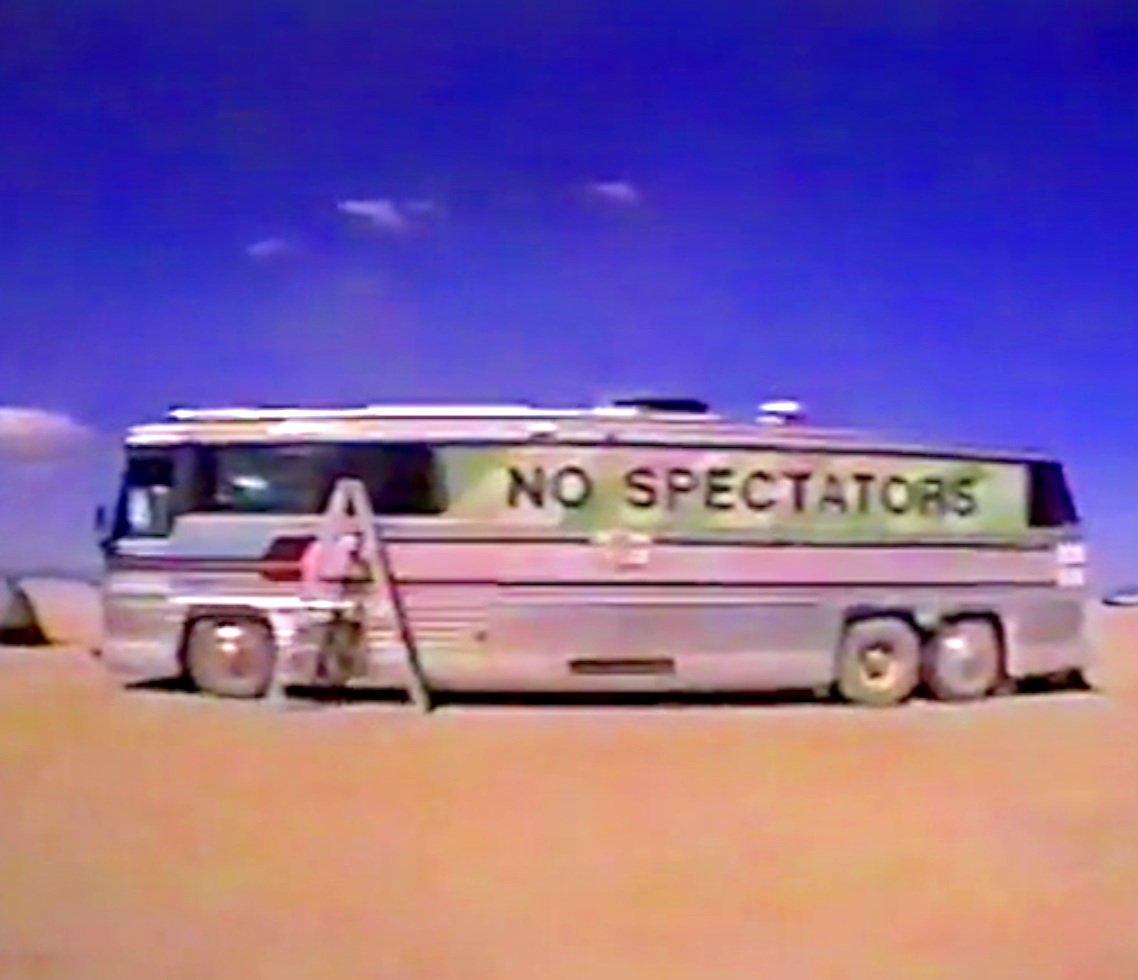This is Burning Man: An Annotated Summary (Pt. 1)
by Brian Doherty
2004
An annotated summary.
Perhaps the best book ever written on Burning Man.
Available for purchase on Amazon and elsewhere.
Information in brackets are notes added by us, based on additional (or in rare cases conflicting) information. This summary does not intend to capture the wonder that is “This is Burning Man”, and is best used as notes and annotations when reading the book.
Prologue: Welcome to Black Rock City
Burning Man started in 1986 as a little ritual for a couple of buddies and their friends on Baker Beach in San Francisco. At first it was nothing more than a reason for some friends to gather. Now, a fully functional city - Black Rock City (BRC) - appears and then quickly disappears around the ritual.
The author first heard about Burning Man (BM) in 1994, having just moved to LA. Hanging out with the Los Angeles Cacophony Society, which had been pulling off absurdist fiery pageants at Black Rock desert already. By 1995, he had heard so much about BRC’s functional anarchy that he decided he had to go - anarchy being one of his primary intellectual interests. He showed up early Saturday morning and left Monday morning, so he only got a small taste. It did seem like a function anarchy for the two days he was there - and everyone seemed, for the most part, thrilled.
Mud fun, Burning Man 1996
But why he knew he’d return was one afternoon it rained and then hailed. Then a full rainbow arc appeared and mud pits formed, with all the bodies of BRC forming a slaippery pile of gray-brown…then I saw a dwarf in full bondage gear car surfing behind a pickup. The world turned to mud and it wasn’t a crisis. It was an opportunity for play and spontaneous shows of spirit and survival.
Burning Man is filled with delights and Dada absurdities, but it’s more than just fun. Tyler Hanson laid out some interesting thoughts in an attempt to define that thing that Burning Man supplies in blessed abundance. He called it the holy moment, “that moment when you know that it is happening and it should be the way it is. It’s the most amazing possible thing that could be happening at the time being, and you are aware of it at that moment…. You cannot have any expectations for the Holy Moment. You must be blindsided and only then can you have this epiphany of, here I am and this is what’s happening, and the moment before I didn’t know but now I know and I will revel in every moment.”
Tyler observed “The Way of Burning Man” is constantly open to reinterpretation, because there is no rule book: “there are thirty thousand reinterpreted reasons as to what is the Way, and really there is no Way - the Way needs to be constantly destroyed and redone again.”
“I think the Way used to be that you had a bunch of people who did everything they did out in the desert when they went home as well. They lived it. They weren’t just putting on a costume. But as the numbers increased, there were a lot of people stepping into a form that was prepared already. You always see the people in costumes - gas mask, fairy, robot, naked guy. It’s like Halloween with these prefab identities, like goblin, alien, witch. Still, for most people that might be the most expression they got in their lives, and hallelujah, we need them. Why Burning Man does work is that it opens the doors to whatever freak anyone might have inside of them that they don’t get to be at home. For lots of people out there, wearing unusual clothing or being able to talk about- or do - drugs or sexual things might be a big explosion of freedom.
The book tells the history of the city that grows and disappears because people want a place to act with joy, and to be together, and to create things for themselves and for their chosen community. It tells stories of what has happened there, what still happens there, and what might be happening in the future because this country, this work, has been fortunate enough to have this city in it, even if it’s only for one week a year.
A Note on Sourcing
One of Burning Man’s principles is “No Spectators”. The author tried to honor that in writing This is Burning Man. He had been to Burning Man four times before he dreamed of writing about it for public consumption. Back in the mid nineties, it still had enough of an aura of “what we do is secret” that keeping it under wraps made a subterranean sort of sense. By 1999, he was convinced that Burning Man was ready for public discussion. He notes that he was late to this realization…. He wrote a cover feature for Reason magazine, mostly about the event’s curious and often rocky relationship with government authorities. (The piece can be found here).
Many stories in the book come from the author’s personal observations. For those he wasn’t present for, they are observations relayed to him by the best recollections a people who were present. Steve Mobia’s audio diaries made from 1990 to 1999 were also used, giving something close to a first-hand memory.
Part One
Ignition
Ignition
Larry Harvey was the adopted child of Author Sherman Oliver Harvey and Katherine Langford Harvey. Larry was born in Portland Oregon and raised by his parents in the north side of the semi-rural Parkrose suburb. [Ed note: He lived at the end of SE Holman Street, an area of farm land developed commercial property in the 70s; his home was replaced by a motel near PDX airport]. His parents had moved from a Nebraska farm to Oregon, but maintained 19th century farmers in values. Larry praised them for their stern old-world values and ethics, their lack of material pretensions or dreams measured in worldly terms.
But he learned little about how to live as a thinking and feeling human being in relation to others. He was smarter than his parents; he knew it, and he was pretty sure they knew it too. His parents looked at him as something of an idiot savant - bright and creative, but what on Earth was one to do with him? Larry was the family subversive. In his adolescence, he posted on his bedroom wall a photo of a dead fetus from Life magazine: “My mother never said anything. No, no one ever said anything. That was my angst. No one would speak about deeper feelings, certainly not in relation to one another.
Larry in front yard, SE Holman St, winter 1953
Larry spent much of his childhood in a state of hypochondriacal sickness to win the attention of a mother who “ didn’t seem to love you until you were ready to die.” Larry grew up distant from his parents and his brother Stewart (also adopted), who was five years older than him. [Ed note: Steward and Harvey were fairly close in their adult lives, and Steward attended Burning Man and documented his experiences in photos. Steward also characterized their childhood as being close, in contrast to Larry’s assessment. Steward’s tribute to Larry can be found here]
Larry’s distance from his father increased when father told him adopting children was the worse mistake of his life. Regardless of an apology (sent via Larry’s mother), the pain remained with Larry, and now the only love Larry thinks is worth a damn is the kind of love we feel for a work of art: unconditional love.
Larry left his parents’ home to serve briefly in the late sixties. He had some unhappy college experiences on the GI Bill [ed: He attended Portland State University, where he met Janet Lohr in late 1968/early 1968]. He then spent the autumn and spring of love [1967] near Haight Street, before returning to Portland.
[ED: Larry returned to San Francisco in the summer of 1968 before moving back to NE Portland, to live with his brother Stewart, Stewart’s wife Lynda and their infant son, Bryan. In the summer of 1969, Larry moved with Janet to La Conner, Washington, where they lived in a decrepit water tower on a cannabis farm. After a police raid, Larry and Jan briefly moved back to Portland before relocating to Corbett Oregon, where they lived for several years. After traveling the western part of the country, including spending several months in rural Montana, they returned to Portland, where Jan finished her degree at PSU. Jan found a job that would allow her to obtain her teaching credentials in Coquille Oregon, and around 1973 they relocated there].
Larry, 1978 at Baker Street
In the early 70s, he moved with Janet to Coquille, a small town in Oregon, where Janet was teaching elementary school. Larry found Coquille to be near paradise, but also started taking the bus to Coos Bay, the nearest town with a substantial library. In 1978, he moved with Janet to San Francisco, [initially living on Ashbury Street]. By the early 80’s, Janet and Larry had broken up. [They broke up around late 1980]. Janet had been supporting him, and Larry found odd jobs to support himself, including grilling hot dogs at The Farm (at that time a punk rock club), working as a bike messenger and driving a cab.
Thanks to a small inheritance, Larry purchased a car and launched his landscaping service Paradise Regained, catering to lower middle class clients who were interested in odd ball ideas that suited their individuality. Larry’s partner, Dan Richman, has a circle of intellectual oriented working men, among these Jerry James, with whom he would build the first Man.
[Ed: Larry was also employed as a gardener during this period by Edgewood, a health care company, was recovering from an unhappy breakup with his girlfriend Paula, and was living with Dan Miller in Alamo Square]
***
Larry married Patricia Johnson in the early 80’s [in 1981] shortly after his relationship with Janet ended, and had his son Trisan [in 1982]. Jerry James also had a young son, and the four of them would go out on play dates together, often building things with wood. About the same time Mary Graubarger became an important influence for Larry.
Mary had come to the Bay Area in the 60s attracted by the Berkeley free speech movement. She began to work as a sculptor, selling pieces out of her car She met Janet Lohr in the mid-70s and by the late 70s, after assisting with setting up Unity Fairs, she began a series of spontaneous art-party happening down on San Francisco’s Baker Beach.
Baker Beach is a beach frequented by nudists, and noted for its seclusion, pinched of at both sides by cliffs, and nearly under the Golden Gate bridge. Mary noted that Baker Beach "was “just a bunch of nude freaks going down to the beach to hang out. I was a sculptor and I’d get bored sitting around the studio, so I’d pick up stuff washed up on shore and build sculptures. We’d stay ‘till the evening and cook, and then it seemed natural to torch the sculptures. It was a personal thing, for fun.” “I liked everything to disappear quickly. It’s more beautiful to have people experience it and then it’s gone.”
She would often do her art gatherings on the summer solstice, but not always. She stopped in the mid-80s. She doesn’t seem to care that her projects sparked Burning Man. “The difference between me and Larry, is that Larry needs to be famous and feel that he has moved society in some way. I don’t need that at all. … I admire Larry because he got what he wanted. Most people would have dropped out when Burning Man must seemed like a piddling daydream. But he was sure of it, and he was right. People seem to need it, and they come from all over the world. But I know it’s hard on Larry’s health and I have no desire for it. Women can have children — fame is like a man’s own child.”
***
It was 1986 and the summer solstice came around and Mary wasn’t doing her thing anymore, so Larry approached Jerry with no specific reason or motivation and suggested they build a figure of a man, take it to Baker Beach and burn it. Larry had once mentioned to a reporter that the first Burn was related to sorry over a woman, but now dismisses it. Some old Burning Man associates swear that such a story was Larry’s official line for many years in the early nineties.
[ED: Larry’s romantic relationships had a significant impact on Burning Man through the years, including its beginning. Dan Miller, Larry’s long time Alamo square roommate had been dating a woman who went by Chrylu, whose roommate was Paula Peretti. Larry had dated Paula Peretti, and while the relationship was unstable, Larry fell hard for her, taking her and Tristan to a Baker Beach solstice gather at the peak of their happiness. A short time later the relationship ended, on an ugly note. This, combined with financial challenges and a general loss of direction, contributed to a nearly two-year funk for Larry. With the approach of the painful two-year anniversary of the happy summer solstice with Paula, Larry decided to try to erase the painful memory, or at a minimum get out of the house with purpose, and used the idea of burning the effigy as a means to accomplish this. Why Larry changed his tune on the origin of Burning Man is anyone’s guess. The story is known by any associated with Larry or Burning Man during the early to mid-90’s. Jerry has referenced the story publicly on several occasions, and Larry’s brother Stewart also has confirmed the story in print in 1995, shortly before the story changed. Perhaps the breakup with Paula was less important than Larry had been reporting, and it was merely a concise answer to the question of why burn a wooden man. Maybe Larry did not want the motivation for burning the first Man to be confused with the significance of the Burn. In any event, Larry typically waved away attempts to understand precisely the origin of the first burn as being a distraction from the importance of the event.]
The figure of the man was built by Jerry with some help from Larry in the “dismal basement garage” of Larry’s ex-girlfriend, Ellen Into (daughter of Whittaker Chambers). Jerry, Larry, their two boys and four or five others dragged the eight-foot man to Baker Beach, doused him with gas, and ignited it. Randomly, they passed Dan Richman and a date, and Dan scoffed uncomprehendingly at their proposed odd ritual.
Larry recalls that “then the most significant thing happened: Strangers ran and joined us. Suddenly the crowd doubled or tripled. The Man was near the waterline, so the people formed a half circle around him and they too were delighted by the flaming humanoid form. It was darkening toward night, as I recall. I could see everyone’s face lit by the flame. We were moved, as one is moved by the enthusiasm of strangers for something you’ve done. … And then a woman I didn’t know ran up and held his hand - the wind was blowing the flame all in one direction. Just as a lark. She was touching it as if in awe of it, but also companionable, like it was something you could lean against. — Ah participation!” “And a guy played a song about fire, improved it on the spot. … In that instant, that gift - it was moving.”
Larry went on to note the significance of the participation of strangers “Those acts of impulsive merger and collective union were what made it so special. I’m very much of the conviction that we would never have done it again if those circumstances had not happened and helped us be so moved by what we’d done.”
2. You May Already Be A Member
Larry used to obsessively watch a grainy video of an early beach burn. One detail on the soundtrack bothered him. A vice could be hard shouting ”Wicker Man!” Larry has always bristled at the notion that his ritual was inspired by that movie, which he sears he didn’t even see until well into the history of Burning Man. “…because some idiot was yelling Wicker Man, it got a name. It was very much a carpentry deal, a fellowship of carpenters. Like my father being a Mason. A Fellowship of the Work. A man built like a house. That’s why Wicker Man bugged me…Burning Man is a great multivalent name because it’s an action and an object and a shared experience all at once.”
By 1987 the Man was nearly fifteen feet tall and took a couple of weeks to build. By 1988 the man was around forty feet, approximately the same size as the current man [without the base]. The first attempt to raise the Man in ‘88 failed, when the pully being used to raise the man popped out of the sand and the Man came crashing down. A second attempt worked, and the Man, already pre-soaked with kerosene, his legs and body stuffed with newspaper and wrapped with burlap skin was ignited. The flaming material blew away, leaving a charred, but still standing man. After some brief police interaction, it was agreed that the Man could be knocked down and then burnt on the beach.
1988 was also the year the Cacophony Society discovered the Man.
***
The Cacophony Society as a direct lineal descendant of the Suicide Club, which existed from 1977 to 1982, the brain child of Gary Warne. The Suicide Club began as a course Warne taught at the Communiversity, SF State University’s contribution to the Free School Movement. It quickly became its own separate secret society.
Chris DeMonterey recalls the Suicide Club initiation beginning at the bookstore Circus of the Soul [at 451] Judah Street, owned by Wayne. They put bread dough on his eyes (he thought it was plastic explosives) and lead him and around 50 others to a van. They were then driven by a circuitous route out to Fort Funston. They were led holding hands down a path and were told they had to stay balance or they’d fall forty feet.
Path to Bunker for Suicide Club initiation (below white line)
Chris claims not to remember what happened at the end of that walk. “No one can say. It was too long ago. I think we had coffee or something.” [John Law shared his notes from the time here, which includes a complete description of the initiation. A description of the second initiation is included in this article on the Suicide Club.]
The Suicide Club sputtered by 1982. In November 1983 Gary Warne died of a heart attack at age 35. [ED: John Law painted his ashes When Warne died of a heart attack in 1983, Law painted his ashes into the top of the north tower of the Golden Gate Bridge].
John Law and Carrie Galbraith
A handful of former Suicide Club members launched the Cacophony Society, and the tradition of “merry pranksters” continued. The boilerplate of the group’s newsletter read “We are a fringe element which is always near the edge of reason You may already be a member!”. By the time the Cacophony Society stumbled upon the burning of the Man, John Law and Michael Mikel were already members. [ED: The book uses “Michael Michael”, which is how Michael identified at the time of writing. He is now more widely known by his legal name “Michael Mikel”, and we use that throughout this summary.]
Law was a Suicide Club alumnus who avoided Cacophony for the first few months because an angry ex-girlfriend among the founders didn’t want him around. Those wounds healed, and he quickly slipped into the role as a chief facilitator, discoverer of strange places to explore, and master climber. Law was a neon sign installer, inveterate bridge trespasser, and maven of secret niches in urban environments. A lover of strange and eldritch literature, he came to SF from rural Michigan (running from a juvenile probation violation rap), and in the estimation of one man who has worked with him - and sometimes clashed with him - for year, he is “a natural-born leader of men.” He has a quiet and chameleon-like handsomeness, with the ability to blend into whatever role circumstances require, his facial hair and hair length changing constantly. He was the prime Suicide and Cacophony liaison with cops whenever necessary.
Michael Mikel was a former computer industry entrepreneur, old enough to have been part of the drugs / sex ferment that made the sixties the sixties. The Suicide Club, as Michael remembers, was so far underground he couldn’t’ find it, although he had heard rumors of initiates as doing the “most incredible, outrageous, and amusing things.” Cacophony, however, had a public newsletter dubbed Rough Draft, which Michael found one day in a Rainbow Grocery. Michael eventually took over and formalized the newsletter. He believed the Suicide Club’s demise was the consequence of its insularity and secrecy. He vowed to make Cacophony more wide open and tried to cross-fertilize with other groups, tendencies and events n the area. He also led the effort to franchise Cacophony, creating mini gangs of mischievous gremlins in any American city where he could find someone to lead them.
Cacophony was not a haven for the cool, but for the childishly minded misfits. “Cacophony was about doing things, having direct experiences. … Part of that involved trying to change the status quo of the culture through public courageousness, street theater, bizarre costuming, and public acts of revolution. More so than Suicide Club, which was more private and underground. They were challenging and growth-producing for the individual, certainly, but I took Cacophony where it was very public and open, inviting people to experience that change. And Burning Man fit into that.” Mikel noted.
Cacophony stages public protests against Fantasia, pretending to represent an absurd conclave of interests: parents upset how frightening it was, environmentalists outrages that it encouraged water waste; obesity activists peeved with the mocking of dancing hippos. They seeded the crowd with compatriots to get in yelling matches with the protesters, and got covered in Time. And then were covered by the Wall Street Journal for fooling Time.
[Other Cacophony antics are covered here]
Less publicly, they were regular explorers of SF’s abandoned buildings, stores and bridges. Colorful costuming and absurdist theme parties built around cultural icons such as Alice’s Adventures in Wonderland and Twin Peaks, public treasure hunts and celebrations of lost American junk culture were part of the repertoire.
A group home presided over by P. Segal on Golden Gate Avenue near Baker Street became a clubhouse of sorts for them. [Many P. Segal’s writings can be found here, and the experiences during the Golden Gate Avenue period are collected here.]
Right after the ‘89 earthquake, the Mission district of SF was empty at night, with rooms available for $250 a month. Earthquake and gang wars led to an exodus, widening the nice for the more daring or reckless to move in, giving them space to work, build, and play in. Nancy Phelps remembers “You always felt safe. Everyone was friends. If you went through the sewers, you knew the person at your back was really at your back.”
* * *
Cacophony began to spread, thanks to conscious effort on the part of Michael Mikel. The author had spent some time with Timothy Leary just before his death, and no one reminds him more of Leary than Mikel - in appearance, twinkle, speech patterns, and style. Bruce Sterling described Mikel’s “running buddies” as “tribal elder hippie-guru characters. Time has given them the faces they deserve. They all end up with this spacey Crowleyan smirk… not seamy exactly, but some kind of terrible wisdom, like a cross between Gandalf and Nietzsche…. When you’re in their company you feel a distinctive witch-doctor vibe.”
A lonely computer animator named Alan Ridenour, who had recently lost his wife to his best friend, found a stack of Cacophony fliers in a Los Angels coffeehouse in the early nineties. He didn’t realize that this group only existed in San Francisco. He imagined an International Cabal of Cacophony and assumed, of course, that they’d have a thriving lodge in Los Angeles. After sending a string of letters with ideas for pranks and events to the PO Box listed on the flier - a box manned by Mikel — and getting no response for months, he began to doubt the organization’s existence. Mikel finally reached out to Al, impressed with some of the ideas and the first escapade of the Los Angeles Cacophony Society was planned and executed by Ridenour, who adopted the Cacophony alias of “Rev. Al.”
They flyered a local UFO devotees’ convention, claiming to be the Brotherhood of Magnetic Light and promising a Space Brother landing at Dockweiler beach. In the air they concocted “a really sad little pathetic hot-air balloon…More like a laundry bag with candles hung under it” But on the ground they rolled out a two-hundred-foot aluminum-foil cross on the hillside and piled it with flowers and burning incense. “We created a magical Christ icon - a plaster Tijuana Jesus with a walkie-talkie shoved up his ass. When an acolyte would approach it with his walkie-talkie on, it would produce this interference squelching sound… I began speaking in tongues. Rich Polysorbate of course starts shooting fireworks into the air for no reason. Then [Mikel] came running up the hill in a silver suit babbling about how is spaceship had crashed.
Ridenour decided he’d take Cacophony in his own direction when he wearied of the “info packs Michael would send about how to run things, as if I’d become an Amway salesman. I did try to adhere to some of the principles and thoughts from the official propaganda. I did use some of their catchphrases as I saw fit. Some of it struck me as too fey, too much of a dancing-on-the-rooftops flavor.” Various SF Cacophonists describe Rev. Al’s new direction with almost awed respect, as edgier than the original.
***
The man burn in 1989 was the first publicized by Cacophony, and was covered by local television. The burn didn’t go as hoped: His support beams were not thick enough for his weight, and he cracked, contorted, crumbed to his knees, head lolling down. They had to burn him in a sitting-kneeling posture. Despite the mishap, the TV coverage continued on cheerily as if nothing was wrong. The coverage encouraged Larry, to the point of obsession.
By 1990 the crowd was so large that many attendees took to crawling along the bluff overlooking the shore to see the show. The crowd was between five and eight hundred strong; estimates by those there vary. The police arrived and wanted everyone to leave. Dan Miller, who had become one of the Man’s builders, decided to negotiate a deal with the police: to raise the Man but not burn him. This was the first time Larry remembers really becoming acquainted with John Law,
Law became the spokesperson for the faction that advocated burning the Man anyway. He was confident that the police were just making the required show of authority and wouldn’t be back. “That would have been a real underground move… Burn it and get away with it". Larry later recalled. But Larry insists he gave his word, and his father’s ghost would smite him if he went back on it. [ED: In other re-tellings, Larry has also noted that those advocating for the burn had no skin in the game… not consequence if things went poorly.]
The Man was dismantled and trudge back up to a lot on Eleventh Street, near Folsom, whose owner had been allowing them to store the Man’s bigger pieces.
By a strange confluence of events, several people in the social circle had become familiar with Nevada’s Black Rock Desert. John Law had been taken out there in 1987 and 1988 by a monster truck enthusiast. Jerry James and a handful of Cacophonists had been there last Labor Day for a gathering of windsailing sculptures (Ya Gotta Regatta, 1989) coordinated by Mel Lyons (known as Mel Function) in collaboration with a pottery maker named John Bogard who lived in nearby Gerlach. The Cacophonists included P. Segal and Kevin Evans. Lyons and Bogard had already been using Black Rock for weird art events, including a giant croquet game (Croquet X Machina, 1988) using trucks as mallets that had made the pages of Sports Illustrated.
Photo: Richard Misrach/California Sunday
Photo: Richard Misrach/California Sunday
Photo: Richard Misrach/California Sunday
Law and Kevin Evans had already been planning a Cacophony excursion to Black Rock Desert, where they hoped to live out some desert fantasies, to build things and destroy them at will.” When the Man burn at Baker Beach fizzled it made sense to them to drag the Man to the desert to destroy it there. But, as Jerry remembers, during this period the Man was “murdered”; The lot he was stored at was converted to a pay parking lot, blacktopped and the Man’s body disappeared. [John Law reports a slightly different story: August 1990, right before the “Bad Day at Block Rock” event, the Man was stored at [350 11th Street (across the street from Slim’s night club) in a paid parking lot] – and the parking lot owner cut up the legs with a chainsaw one night when nobody else was around, essentially destroying the Man. Jerry James had secured a parking spot, but the legs were sticking out, into the next rentable space. “Ya gotta understand,” John Law says, “we were so fuckin’ broke it was retarded. So getting just one parking space to put the Man in was kind of typical.”]
At this point Larry and Jerry no longer wanted to work together for reasons neither man will discuss and Jerry at that point did not plan to having anything further to do with Burning Man. Law then supervised the rebuilding of the Man after hours in the sign shop he worked in, the American Neon Sign Company. When discovered by his boss, Law showed him the first news clip, to convince him there was a sensible, media-approved reason for what he is doing.
The first official announcement was contained in the September 1990 edition of Rough Draft, the “Official Organ of the SF Cacophony Society”:
“An established Cacophony tradition, the Zone Trip is an extended event that takes place outside of our local area of time and place. On this particular expedition, we shall travel to a vast, desolate white expanse stretching onward to the horizon in all directions. . . . A place where you could gain nothing or lose everything and no one would ever know. A place well beyond that which you think you understand. We will be accompanied by the Burning Man, a 40- foot- tall wooden icon which will travel with us into the Zone and there meet with destiny. This excursion is an opportunity to leave your old self and be reborn through the cleansing fires of the trackless, pure desert.”
[P Segal had derived the idea of a “zone trip"] from Andrei Tarkovsky’s Stalker, a beloved art-school film that features a mysterious Zone that looks like the rest of the world bu tin which bizarre, inexplicable things occur. A caravan of about 80 Cacophonists drove from San Francisco to Black Rock desert, stopping for breakfast at Bruno’s restaurant. They then drove 12 miles past town to an accessible turnoff onto the Black Rock Desert. John Law drove the Man in a rented Ryder truck. They all got out of their cars. Michael Mikel drew a land in the plays surface, and the Cacophonist walked over it, They were in a different place now. Reality had mutated because they willed it thus. They had crossed into the zone.
3. It Felt Like Glory
If you traveled to Burning Man in the early to mid-nineties, you had only a treasure-map clues as to where you were going—- a turnoff and then this many miles and then turn so many degrees at this flag marker and head toward that peak. If you were off by less than a mile you could go vectoring forever away from your direction, never seeing it.
The U.S. Bureau of Land Management (BLM) has this to say about Black Rock Desert (done for a later Burning Man): "The environment for the proposed action contains no true soils; surface or ground water; vegetation; wildlife; threatened or endangered species; wild horses; paleontology; solid or hazardous waste material; wilderness; or cultural resources."
Once in the desert, you will live on its terms, according to its nature. Once the crust on the Playa is broken a finely powdered dust will cover your skin and invade your lungs and nasal passages. In the early, the day would e spent talking and reading. Shade structures were built and would fall down. A culture of gifting began to develop as well.
Burning Man was not yet exploding with art or public tomfoolery - the idea that it was an arts festival did not arise until 1992, and did not become a serious reality until a few years after that. When listening to people reminisce about the early days, recent participants (and the author) might find it all to sound uncompelling. Fed up with people harping on the old days being better/cooler/purer/more fun, Larry had taken to denigrating the “good old days” of early Burning Man… “Sure it was a blast,” he’ll deadpan. If you were lucky you could get someone to drag you around on a tarp behind their car.”
Fly Hot Springs
So why did they keep doing it? The hot springs of lack Rock area were a big draw, with the rich, vivid, phantasmagoric Fly Hot Springs most prominent in sweet nostalgia, the geyser a frighteningly awesome fleshy protuberance all the colors of the solar system its spillage forming various pools, the faraway ones gloriously comfortable and the nearer ones fatally hot.
Larry also noted that the nothingness of the desert contrasted sharply with anything that does exist there. “Something so very large and so startlingly like ourselves just seemed numinous. It was a breathtaking thing. And who is not affected y oceanic space? Only someone with an imaginative disability.
And then there is the Cacophony spirit, the Zone Trip spirit, which delighted in doing what seemed inexplicable. Regarding erecting the Man, Larry notes “Who would do this? We could let our imaginations run wild - who had ever done it in the history of mankind? It felt like glory. It felt like glory. That sense of special election we all shared - as time went on in the next few years, some attached more value to it than others. We were3 all close, but inherent difference started to show, things started to diverge. What I didn’t see was that to some people this sense of special election depended on the exclusion of others, The dark side of it became that as more people showed up, there was more resentment of those people. To me the playa seemed so big it could accommodate a nation.”
***
Mud People: Dan Evans and Sebastian Hyde
During the first year at Black Rock a few people realized that combining the dust with water made a deliciously gooey slick mud that dried and flaked and transformed you into a bizarre, primitive creature of the earth, a Mud Person,
The first time the Man burned in Black Rock, his burner was also burned. Dave Warren, a founder of the Suicide Club, spewed flames from his mouth to ignite the figure, and the wind blew the fire back into his face. No permanent damage was done to the flesh man, and the wood one burned to the ground. Steve Mobia, a Suicide Club alumnus having his first experience with the Man, saw the fireworks and flares in his head shoot off as the fire claimed him and reflected that they were the final thoughts in the Man’s head, winged heavenward. Mobia noted that the Man inspired an awe that approached religion.
Steve Mobia arrived in San Francisco in the late seventies after being thrown out of college in Long Beach for a bit of performance art that accompanied a poem he read to a class. He urinated into a bucket, filled a quirt gun with the effluent, and began firing off over his fellow students’ heads. Then he crushed three mice on a table. Maybe San Francisco was a better for him anyway. He went there to pursue his interest in experimental film. (Some of his work can be viewed here).
Mobia became one of Burning Man’s first civic functionaries: the lamplighter, the one who lit the kerosene lamps that hung from posts on a path toward the Man. As the encampment/city grew and the need to demarcate roads grew with it, Mobia soon became chief of a band of lamplighters. He’s retired now, but the tradition has continued. Clad in flowing robes with flames that rise from the hem, hundreds of monastic volunteers silently trudge through BRC at dusk every evening, bearing over their shoulders poles from which hang the oil lanterns that they hoist to the lamp spires.
Mikel at Black Rock City in 1995
In addition to the dim lighted streets, officers of the peace were added by Michael Mikel in 1992. He and Rob Schmidt began acting as the Black Rock Rangers. They mainly patrolled the borders surrounding the civilizations, and rescuing people who had gotten lost or had a mechanical breakdown. Michael adopted the identity of Danger Ranger, the “legendary protector of our desert society” in later BRC literature.
Peter Doty noted about early burns “It always surprised me that people were doing art out there. I didn’t think of it as something people would necessarily do. I thought of it as more of a camping trip/party type of thing. So anytime anybody did anything, it was like, “Oh, wow, someone did something!’. And back then, people actually slept at night. There weren’t a lot of generators. In 1991, I’m not sure there were any generators.”
Doty is generally recognized as creating Burning Man’s first theme camp, although some argue other groups such as the Bolt Action Rifle Club in 1990, pith-helmeted adventurers portraying the spirit of soldiers of the Raj with tea and authentic weaponry predated his efforts. Doty himself bows down before the efforts of Vivian Perry. She pulled of something he remembers as “Elegant Camp” Vivian “was going all out for elegance, and it blew everybody’s mind. She had a champagne bucket and fresh-cut flowers. She was eating oysters and caviar off china and silver, and it was all over-the-top extraneous and superfluous and completely inappropriate, and that was what was so wonderful about it.”
“Vivian was the talk of the playa. She managed to stay pristine the entire weekend…. Her white silk blouse was completely spotless, and her black velvet riding pants looked like they’d just come out of her drawer. Not even any dirt on her boots…. Turned out she was taking four showers a day and had multiple pieces of the same outfit; [she also] had a little damp rag she was carrying around, wiping of her boots constantly. We hadn’t seen anybody do anything so conceptually obsessive out there yet.”
Doty, with ideas supplied by Lisa Archer and Amanda Marshall, formed Christmas Camp in 1993 - He dressed as Santa, constantly blasted tapes of Christmas carols, festooned the camp with decorations, and supplied boozy eggnog.
***
John Law and his then girlfriend Vanessa Kuemmerle would drive out to the playa ahead of the event to meet with the BLM people to show them the planned site for that year’s gathering. They would rent a nice car, fully insure it, and “drive it hard”. If it returned with bullet holes, not many questions were asked.
The legendary glory of those days was the Drive-by Shooting Range. It was miles across the playa by the side of the dirt road leading toward Frog Hot Spring, a small, warm, sulfurous pond beneath a shade tree. Mikel puckishly convinced his fellow Cacophonists - and eventually even some locals - that Frog had once been the site of a whorehouse, and that traditionally it had been known as Bordello Hot Springs.
JD Boggman on Michael Mikels “5:04 Special” car
The first Drive-by Shooting Range was managed by Joe Fenton, a former army man who fell in with Cacophony. By the late nineties, he was a higher-up in the Black Rock Rangers, using the playa name J.D. Boggman. He was initially refused entrance to the Black Rock Rangers: “They wouldn’t let me e a Ranger until the Burn in ‘94… Michael said I was too aggressive. And eh was right, I was. I didn’t take shit, always packed guns. Even if I was wearing a suit, I’d have a shoulder holster. Hey, I;m in the middle of nowhere with a bunch of acid heads - I’m going home alive. Fuck you, I don’t care what your voices tell you to do. You’re not doing it to me.” (He later left the organization after a public altercation with another Black Rock worker).
At the Drive By Shooting Range, you could set up anything you wanted and shoot at it on bike or car. Michael Mikel’s prized chariot, the 5:04 Special, was a favorite out at the range. It was an Olds Cutlass Supreme that had been crushed by a brick wall from during the 1989 Earthquake, which occurred at 5:04 pm.
Kevin Evans, who Mikel often let drive the car, recalls sending families of strangers into tearful panics when he’d innocently pull over on long road trips to picnic in the grass. They were certain they had stumbled upon a horrific accident scene.
Also involved in the Drive By Shooting Range was Kimric Smythe, a former air force man and an explosive expert from Survival Research Laboratories (SRL). Kimric was responsible throughout the nineties for the pyrotechnics on the Man, along with his father Bill, a former United Nations functionary. SRL never had a presence at Burning Man (despite erroneous press reporting to the contrary).
***
In the first few years in the desert people realized a lot of fun things could be pulled off that couldn’t happen in civilazation. Kimric Smythe build a wall of fire with a long line of sawdust and kerosene, a flat plane of flames bursting abruptly from the ground. Later he and his wife would festoon themselves with as many projecting and bursting fireworks as they could fit on their bodies and dance and cavort around.
In 1992 the first artist not from the SF Cacopony scene arrived at Burning Man. Serena de la Hay came from England and made human-sized wickers on0site. She spent much of the summer living in Nancy Phelp’s house, working on them there as well.
1992 also marked the first plane crash in Black Rock City - a plane flipped on landing.
The first music camp also showed up that year. The “Rave Camp” was about a mile or so from the main event, introducing loud amplified music to the event. Here’s an article on the history of amplified music at Burning Man.
a
By 1992, Burning Man was a ticketed event, costing around $25 [Ed note: this is not accurate. In 1992, as in the prior years in the desert, a cash donation was requested, primarily to pay for portapoties, permit fees and insurance. In 1992, it was $2 per day per person. In 1993, a cash donation of $40 per person was requested. In 1994, a $30 per person donation was required, but a ticket was also issued (in the form of a number on an envelope to be given to the gate). See below the evolution of tickets].
The 1992 Black Rock Gazette, including requests for $2 per day contribution
It was easy not to pay in the early 90s. John Law helped finance transportation; Dan Miller and Chris Campbell spent most of their summer building the man for free. (Jerry James came back in 1991 but never reclaimed much of a role in executing the event).
***
Larry believed from early days that Burning Man would become more significant, with long-lasting effects and a profound influence on society. He had conversations with Steve Mobia on the topic as early as 1991. Along with Nancy Phelps, who had become Larry’s administrative assistant in the early 90s, Larry believed Burning Man would big. Nancy envisioned thousands of people with a lot of art and media coverage.
By 1993 media from HBO, Brazilian and Canadian TV, PBS, and local news had covered the event.
***
Desert Siteworks. From 1993 to 1995, William Binzen, a photographer, organized events that were more like what Burning Man later became. With the help of John Law and Michael Mikel, and other artists he set up multi week encampments at area hot spring (each year a different one: Black Rock Hot Springs, Trego and then Frog a/k/a Bordello).
[ED Note, by 1992, the Cacophony Society started to put as much, if not more interest in Desert Siteworks than Burning Man. From the Cacophony Society: A huge area around Trego Hot Springs that had been a material storage for the railroad was repurposed (with the express intent of returning the area to its original condition) into a colossal art canvas containing over twenty earthworks and surface installations. Rituals, performances (for the participants only – there was no audience) and ongoing fabrication and modification of large-scale installations went on for ten days. These sessions in 1992 at Black Rock Springs, 1993 at Trego and 1994 at Frog Pond Springs at Garett Ranch pioneered the “Intentional Community” philosophy that informs and inspires the best components and participants of the Burning Man Festival to this day.]
***
Around 1995 Burning Man adopted the (virtually) no commerce rule for the gathering. But before then there was limited selling. Flash was selling tacos, hamburgers and beer. Sebastian Hyde and Joe Fenton sold t-shirts, and Fenton also sold Tarot Cards inspired by Burning Man. Chris DeMonterey sold official Burning Man Blast Shields, transparent Plexiglas sheets through which to view explosions and fires.
In 1993, a banner demanding “No Specators” was hung on the side of a bus (which was quickly vandalized by the Billboard Liberation Front to read “NO S E TATORS” [Ed note: aka John Law].
***
Chris Radcliffe was fleeing a lurid life in Los Angeles in the late eighties and ended up in San Francisco in a sales job with the neon sign company that employed John Law. “He had a cheap suit and a cheap attitude, but there was something about him” Law recalled. Radcliffe first entered the world of Burning Man and Cacophony at the Fort Mason barge event in 1991. The Burning Man crew had convinced a local arts group to donate the use of a barge onto which to raise the man and display him once again in his home town. Getting the barge in place almost turned into a disaster when all the ropes were temporary released to get a photo opportunity with Law and Radcliffe aboard and floating out to the Bay. However, ultimately the barge was in place, and with effort the man stood between Docks 3 and 4 for a week in San Francisco.
Fascinated with the barge experience, Radcliffe drove out to Burning Man with a couple of friends in 1991. On the last stretch, he started collecting the corpses of the suicidal jackrabbits that haunt Hwy 34 after dark. He wanted to feed them to his dog. He cut off one jackrabbit’s head with metal shears. Later he and Sebastian Hyde jumped on the hood of the 5:04 Special, with Kevin Evans driving. Radcliffe and Hyde tried to balance themselves by each grabbing a rabbit ear. They stood precariously, a rabbit head floating between them. Radcliffe ordered Kevin, “Head whichever way the rabbit points” and they surfed the hood of the car. “I realized I’d done the most dangerous thing I’d done in years… And that gave me an incredible sense of freedom”, Radcliffe recalls.
On Sunday mornings, as the sun rose on the last day of the Man’s corporeal life, a ritual developed. Kimric Smythe would appear at the feet of the Man wearing a cow’s-skull helmet, pushing himself on a little hand truck with a horse’s head on it. He was the Java Cow, and would distribute coffee to all those who approached with mugs. The Cow would ask if you wanted cream or sugar. The proper response was to shout back, en masse, “No! We like it black!'“ and down the brew.
[Ed note: This ritual was memorialized in the 1995 Burning Man ticket, which shows Kimric in full cow.]
Upon finishing their coffee, everyone would dash to his or her car, then a high-speed race, fifteen or twenty cars in a ragged row, would commence heading to the edge of the playa and the Black Rock Hot Springs, where they would watch the dawn.
***
By the mid-nineties Burning Man was no longer just Burning Man, an event held one weekend a yer. It was “The Burning Man Project”, and thinking preparing and promoting it were beginning to take a dozen or so people’s time for many months.
Stuart Mangrum, who became Burning Man’s press liaison and propagandist in ‘93 and left in ‘96 loved the term The Burning Man Project. “It sounded a little bit scientific, a little bit social controllish and a little bit Alan Parson. Perfect.
Lingam, 1993
More out of hope and imagination than reality, Larry had dubbed the event the “Black Rocks Arts Festival” in 1992. (It has continued being plain old Burning Man ever sense). But big ambitious art did start to show up. Pepe Ozan became one of the art kings of early Burning Man. Every year, he built new and more elaborate variations on his fire lingam, which eventually evolved into creepily alive-looking clusters of materials. Pepe staged “operas” around them - mixtures of drumming and dancing and chanting with lovely-scary costumes and dark-sexy bodies that became a central attraction through the rest of the nineties.
In 1993, Chris DeMonterey started building his annual (with some years off) series of increasingly large camera obscuras, usually in pyramid constructions that people could crawl inside to see a projected 360-degree image of Black Rock City.
Art cars were also increasing in numbers. John Law had invited his buddy Harrod Blank art-car maker and booster who was working on both a book and a film documenting the phenomenon of motorized vehicles altered and tricked out. [Ed: It was actually Michael Mikel who was friends with Harrod and led to his attendance at Burning Man. See here.] Harrod knew almost every art-car driver in the country and spread the word.
Four thousand people were on the playa by ‘95 and media from Spin to HBO to the New York Times to Outside magazine had covered the event. In one film documentary, shot around then, probably 1994 or 1995, Larry Harvey is seen lounging against a tree. He’s talking about negativity and evil forces, and he says the devil isn’t welcome in Black Rock City.
But then he pauses and thinks about it. Well, maybe they could invite the devil out. “Maybe we’d learns something about ourselves.
They did. And they did. [Ed note: The video was from 1994, with a bit of a different quote]



